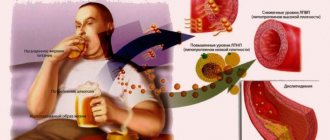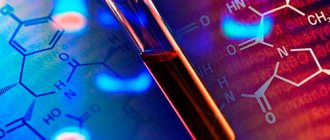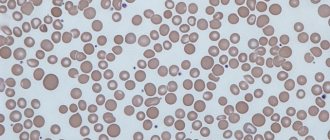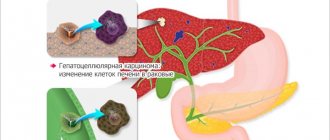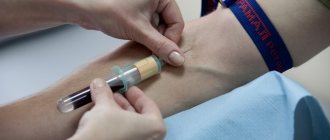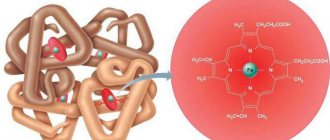There are several reasons and conditions in the body when sugar is elevated without diabetes. Read more in the article.
Diabetes mellitus is a pathological change in the body that results in impaired absorption of glucose. Many doctors, if they see elevated sugar levels in a patient’s blood test, make a diagnosis of diabetes mellitus. But this is wrong, since sugar can rise in a healthy person even if there is no diabetes. In this article we will look at why this happens and under what conditions and life situations.
Impaired glucose metabolism
To understand why sugar levels rise, it is necessary to determine the specific disorder in the process of carbohydrate metabolism. Glucose is a monosaccharide that actively nourishes the brain and provides energy to the entire body. It is formed from amino acids from eaten proteins and polysaccharides obtained from carbohydrate foods.
In a healthy body, after resorption (absorption) of a monosaccharide into the systemic circulation, its main part interacts with insulin. The pancreatic hormone moves glucose molecules into the cells and tissues of the body. To cover physical and mental energy costs, timely delivery of the monosaccharide, its adequate perception by cells and rational consumption are necessary.
A failure of a well-functioning mechanism causes:
- temporary inhibition or complete stop of insulin synthesis by pancreatic cells;
- decreased cellular sensitivity (sensitivity) to the hormone, otherwise insulin resistance.
In both cases, excess glucose accumulates in the blood, which is fraught with the development of diabetes mellitus.
Physiological increase in sugar
Many factors can provoke an increase in glucose levels.
This can happen in a completely healthy person in the following cases:
- With an unbalanced diet high in carbohydrates. In a healthy body, the increase in the indicator will be temporary, insulin will return everything to normal. If you are overly fond of sweets, you should think about the inevitability of obesity and the deterioration of blood vessels.
- When taking certain medications. This includes non-selective beta blockers, some diuretics, and glucocorticoids.
- Stress, excessive physical and mental stress lead to loss of immunity, disruption of hormone production and slowdown of metabolic processes. It is known that during anxiety and stress, the production of glucagon, an insulin antagonist, increases.
- Insufficient physical activity (physical inactivity) causes metabolic disorders.
- For severe pain, in particular with burns.
In women, increased blood sugar may also be associated with premenstrual syndrome. Alcohol consumption provokes hyperglycemia.
Video about the reasons for increased glycemic levels:
Blood sugar levels
Blood sugar levels vary throughout the day. What the glucose concentration is depends on the composition of the food consumed, the degree of physical activity, and the neuropsychological state. Morning blood sugar levels taken on an empty stomach are considered an indicator of carbohydrate metabolism.
Postprandial glycemia (glucose level after eating) is characterized by higher rates. The norms for glucose levels in blood plasma are regulated by reference values for clinical diagnostic hematology. The unit of measurement for glycemia is the molar mass of glucose in a liter of blood (mmol/l).
To determine your sugar level, you need to take a capillary (finger) or venous blood test. The difference in indicators is 12%. With healthy carbohydrate metabolism, the fasting blood glucose level has a stable value relative to the body's homeostasis (constancy of the internal environment).
For capillary blood, the accepted values are 3.3–5.5 mmol/l, for venous biological fluid – 3.7–6.1 mmol/l. After eating, glucose levels increase as glucose formed from the foods eaten enters the bloodstream. The highest blood sugar is recorded after an hour of eating.
In capillary blood, normal values are 8.9 mmol/l. The optimal level of postprandial glycemia is measured 2 hours after eating. The results of blood from a finger should not exceed 7.8 mmol/l, from a vein - 8.7 mmol/l. In the evening, sugar may rise slightly, which is due to the physical stress that the body experiences during the day.
Before going to bed, values of 5.7–5.8 mmol/l are considered normal. The lowest glucose level is 3.9 mmol/l, recorded between 2 and 4 am. In children, standard indicators are slightly different from adults, which is due to the development of the hormonal and immune systems.
Norms for children on an empty stomach (in mmol/l)
| Age | up to 1 month | up to a year | up to 3 years | up to 7 years | up to 14 years old |
| Norm | 2,7–4,4 | 2,8–4,4 | 3,5–4,5 | 3,3–5,3 | 3,5–5,4 |
A slight increase in glucose concentration is allowed:
- For people who have crossed the sixty-year mark. An increase in values up to 6.6 mmol/l is not considered abnormal due to an age-related decrease in the sensitivity of body tissues to the effects of insulin.
- During menopause and the period preceding female menopause. When experiencing a dramatic hormonal change, the body experiences stress and loses control over the perception of insulin. Morning sugar levels may be equal to evening values.
- In women bearing a child. A shift in the lower limit to 5.1 mmol/l is associated with a change in hormonal status. The activity of the sex hormone progesterone, responsible for preserving the fetus, partially suppresses the production of insulin, and excess weight prevents its proper absorption.
In all other cases, non-standardized results are grounds for additional diagnostics. It is very important to promptly find out the true cause of unstable glycemia. This may help prevent the development of type 2 diabetes.
Determination methods
A basic test for sugar content is carried out by collecting venous or capillary (from a finger) blood on an empty stomach. In case of deviations from the norm, extended blood microscopy is prescribed, including:
Blood sugar measuring devices
- GTT (glucose tolerance testing).
- HbA1C analysis (assessment of glycated hemoglobin concentration).
Using a glucose tolerance test, the level of glucose absorption by the body's cells is determined. The analysis is carried out in two stages: an initial blood sample on an empty stomach, and a second blood sample two hours after exercise. As a load, the patient drinks an aqueous solution of glucose (75 g per 200 ml of water). The results are assessed through comparison with standard indicators.
Glycated (glycosylated) hemoglobin is the result of the interaction of glucose and protein (hemoglobin). HbA1C analysis evaluates sugar levels in retrospect, over the past 120 days - the lifespan of red blood cells. The HbA1C test result is determined according to the patient's age. The normal indicator up to 40 years is
| Age | Norm | Limit level | Deviation | ||
| 40+ | <7,0% | 7,0–7,5% | >7,5% | ||
| 65+ | <7,5% | 7,5–8,0% | >8,0% | ||
If glucose tolerance is impaired, prediabetes is diagnosed - a condition in which sugar levels are consistently elevated, but do not “reach” the norms for diabetic values. Prediabetes is not an official disease, but nevertheless requires emergency treatment to prevent true type 2 diabetes from developing.
Reasons for increasing sugar levels
Hyperglycemia occurs due to pathological endogenous disorders (within the body) or under the influence of physiological factors. The latter are due to the peculiarities of lifestyle and individual preferences.
Elevated blood glucose is primarily a clinical diagnostic sign of diabetes mellitus or prediabetes
Diabetes mellitus and prediabetes
Endocrine pathology is characterized by stable hyperglycemia against the background of impaired carbohydrate metabolism. In endocrinology, there are three main types of disease with corresponding causes of excess sugar in the blood:
Folk remedies for high blood sugar
- Insulin dependent type 1. Progresses in children and adolescents due to the cessation of insulin production by pancreatic cells. The causes of insulin deficiency are genetic predisposition or autoimmune disorders.
- Insulin-independent type 2. It develops in adults (usually after 40 years) due to the inability of cells to adequately perceive insulin. Factors in the formation of insulin resistance are chronic liver and pancreas diseases, obesity, and alcoholism.
- Gestational diabetes mellitus (GDM). Occurs during the perinatal period in 4–6% of women due to hormonal imbalance and increased need for glucose during pregnancy. With the right therapeutic tactics, GDM is eliminated after delivery.
Diabetes mellitus types 1 and 2 are irreversible diseases. Once the diagnosis is confirmed, the patient is prescribed lifelong treatment with hypoglycemic medications. Prediabetes is a condition of the body in which the perception (tolerance) of glucose is impaired.
Fasting sugar is elevated to 6.1 mmol/l, which is abnormal, but does not characterize true diabetic hyperglycemia. Unlike diabetes, prediabetes can be eliminated if diagnosed in a timely manner.
Important! Prediabetic condition and diabetes mellitus are not diagnosed based on a single registered hyperglycemia. The definition of the disease includes a set of laboratory tests of blood and urine.
Other pathologies
In addition to diabetes, glucose concentrations may increase in other chronic diseases:
- pathologies of the pancreas and liver (pancreatitis, pancreatic necrosis, hemochromatosis, cystic fibrosis, hepatitis, cirrhosis, fatty hepatosis);
- hypersynthesis or deficiency of adrenal and thyroid hormones (Conn's syndrome, thyrotoxicosis, Graves' disease, Cushing's syndrome);
- hypertension stages 2 and 3, cardiac diseases;
- history of pancreatectomy (surgery to remove the pancreas).
Glycemic levels are partially influenced by TBI (traumatic brain injury) in the area of the hypothalamus, which controls endocrine activity.
Non-pathological factors
The following are the causes of high blood sugar that are not associated with abnormalities in the functioning of internal organs:
- Uncontrolled drinking. Ethanol causes destruction of pancreatic cells, which means that the synthesis of insulin, the main supplier of glucose, is disrupted.
- Distress (constant neuropsychological overload). The condition is characterized by increased production of adrenaline, norepinephrine and cortisol. These adrenal hormones inhibit insulin production. If their level rose, the concentration of insulin decreased accordingly, and glucose remained unspent.
- Gastronomic preferences. A large amount of simple carbohydrates (confectionery, baked goods, sweet drinks) in the diet contributes to the gain of extra pounds. With visceral obesity, glucose cannot penetrate the cells because the tissues lose the ability to adequately perceive insulin, and the vessels are clogged with excess cholesterol.
- Incorrect hormone therapy. Long-term use of hormone-containing medications disrupts the body’s own hormone production mechanism.
- A hypodynamic lifestyle associated with unhealthy eating behavior. With low physical activity, the generated glucose is not consumed, but is concentrated in the bloodstream.
- Polyvitaminosis of groups B and D. Vitamin deficiency invariably leads to the failure of all metabolic processes in the body, including carbohydrate metabolism.
An abundance of sweets in the diet is a step towards unstable glycemia
Regardless of the cause of origin, identified hyperglycemia indicates a violation of the functional abilities of the body. Timely diagnosis of the root cause of an increase in blood glucose levels significantly increases the chances of maintaining health.
Additionally
Morning hyperglycemia deserves special attention. In diabetics, this condition is called “dawn syndrome.” Why does blood sugar rise in the morning when the body is in a hungry state? In the absence of diabetes mellitus, this may be due to:
- Refusal of evening meals. A hungry body releases reserves of glycogen, a polysaccharide stored in the liver.
- An abundance of sweets eaten before bed (the indicator increased due to excessive amounts of sugar that were not consumed during sleep).
- Overdose of hormone-containing drugs. In women, this may be the wrong type of oral contraceptives.
A sharp increase in sugar can cause a nighttime attack of hypoglycemia, provoked by alcohol poisoning.
Causes
Risk factors that can cause high blood sugar include:
- genetic predisposition;
- poor nutrition (especially consumption of large quantities of baked goods and sweets);
- irrational use of medicines;
- bad habits (especially alcohol abuse);
- heavy blood loss;
- deficiency of vitamins in the body (especially B1 and C);
- excessive physical activity;
- carbon oxide poisoning;
- frequent stressful situations.
With the development of gestational diabetes in the early stages of pregnancy, there is a risk of developing fetal pathologies, including serious ones.
Elevated sugar levels are observed in diabetes mellitus, Itsenko-Cushing syndrome, stroke, heart failure, epileptic seizures, and some pathologies of the thyroid gland, stomach and intestines. The risk group includes women with polycystic ovary syndrome, as well as people with low potassium concentrations in the blood.
In women, an increase in sugar can also be observed during premenstrual syndrome, during pregnancy. Hyperglycemia in pregnant women is caused by changes in hormonal levels and the associated low susceptibility of body tissues to the action of insulin. This condition is called gestational diabetes. Often it occurs in the absence of any clinical manifestations, is detected only during laboratory diagnostics and goes away after childbirth. When gestational diabetes develops in the early stages of pregnancy, there is a risk of developing fetal pathologies, including serious ones: heart defects, cerebral palsy, congenital cataracts, etc. In some cases, gestational diabetes can turn into true diabetes. The risk group includes pregnant women with a family predisposition to diabetes, obesity, arterial hypertension, and a history of repeated miscarriages.
Doctors note an increase in the frequency of detection of hyperglycemia in children. This phenomenon is associated with regular consumption of large amounts of fast food, early introduction of cow's milk and/or grains into the diet, drinking water with excess nitrates, and nervous disorders caused by an unfavorable psychological climate in the family. In addition, hyperglycemia in children is often observed after influenza or rubella.
Symptoms of hyperglycemia
Severe symptoms of increased amounts of glucose in the blood appear with persistent hyperglycemia. Periodic “jumps” in sugar do not make themselves known too brightly. The first signs of unstable glycemic levels are similar to common malaise caused by overwork.
You should listen to your body if the following symptoms persist:
- Decreased physical endurance and slowed brain activity. Increased weakness and fatigue are the result of an insufficient supply of glucose to brain cells, nerve and muscle fibers.
- Cephalgic syndrome (otherwise known as headaches). With excess sugar, blood circulation is completely disrupted, which reduces the supply of oxygen to organs and increases blood pressure (blood pressure). In addition, attacks of nausea may occur that are not accompanied by dyspepsia (difficulty digestion).
- Chronic sleep disorder with a shift in the rhythm of hormone production (dysania). Pronounced manifestations are late falling asleep, difficulty getting up in the morning, caused by inadequate functioning of the central nervous system (central nervous system), which needs glucose.
- Polyphagia (excessive appetite). With insulin deficiency or insulin resistance, the hypothalamus loses control over the feeling of fullness. A person begins to eat often and a lot, but due to metabolic disorders, body weight may not change.
- Polydipsia is a syndrome of constant thirst. If the glucose level is higher than normal, an increased amount of fluid is required. Resisting dehydration, the body requires replenishment of water reserves, otherwise it begins to draw moisture from skin cells and internal organs.
- Pollakiuria is a frequent urge to urinate. Increased blood sugar impairs the renal function of reabsorption of free fluid. Against the background of increased volumes of water consumed, bladder emptying becomes more frequent.
- Heart rhythm disturbance. High blood pressure and insufficient oxygen supply with hyperglycemia lead to tachycardia (rapid heartbeat).
- Weakened immunity, expressed by frequent colds.
Uncontrollable thirst is one of the symptoms of true diabetes
Hyperglycemia is manifested not only by somatic symptoms, but also by external changes. The main visual signs include:
- Dryness and flaking of the skin, a decrease in its ability to recover from damage, the appearance of hyperkeratosis (rough calluses on the feet). When blood sugar rises, the outflow of tissue fluid becomes difficult and metabolism in the skin is disrupted.
- Telangiectasia (spider veins on the legs). Tiny sugar crystals clog and destroy capillaries.
- Brittle nails and thinning hair. Failure of metabolic processes prevents the complete absorption of nutrients and vitamins.
With increased glucose levels, the interaction between the endocrine and autonomic nervous systems is disrupted, resulting in loss of control over heat exchange. This is manifested by the syndrome of excessive sweating (hyperhidrosis).
Important! Symptomatic complaints are the basis for the doctor to order a basic blood test to check sugar levels.
Symptoms
Signs of high glucose do not appear immediately. In the early stages, the symptoms are very vague and unnoticeable, so the ability to start treatment on time is greatly reduced; it is necessary to undergo tests. If you notice one of the following manifestations of pathology:
- Constant strong thirst. This is the main and main sign of hyperglycemia; a person is constantly thirsty. This is due to the ability of glucose to draw water from the peripheral organs of tissues. When the sugar value is 10 mmol, it enters the urine and captures water molecules. This leads to frequent urination and dehydration.
- Dry mouth becomes a consequence of the previous symptom.
- Headache occurs when important electrolytes are removed from water and dehydration occurs.
- Skin itching, numbness, tingling of fingers and toes.
- Extremities that are cold to the touch, pain when moving. This symptom becomes a consequence of impaired blood supply and microcirculation in the extremities.
- Decreased vision.
- Problems with the gastrointestinal tract (diarrhea or constipation), loss of appetite.
- Increased body weight due to insufficient insulin action
- Development of nephropathy (kidney disease).
Among women
Most of the symptoms, if sugar is high, are the same in men and girls. There are also a number of characteristics that are more characteristic of a particular gender. These for women include:
- dry skin, it becomes rough and itchy;
- itching of the skin in the intimate areas;
- hair loss, brittle nails;
- even small wounds do not heal well, there is a risk of developing pyoderma (a purulent, inflammatory skin disease), a fungal infection is possible, blisters appear on the extremities;
- manifestation of neurodermatitis;
- nephropathy often occurs;
- allergic rashes on the surface of the skin.
In men
The clinical picture in the male half of the population is similar to the general signs of pathology. There are some differences that are unique to guys. The following symptoms are identified:
- severe itching in the anus, groin area;
- the development of neuropathy, angiopathy leads to impaired potency;
- the foreskin may become inflamed due to frequent urination;
- decreased performance, increased fatigue;
- low level of regeneration;
- arterial hypertension;
- constant weight gain.
- Diet for high blood sugar
- Normal blood sugar levels after meals in women, men and children
- Low blood sugar - causes and symptoms in women, men or children, treatment and prevention
Dangerous consequences of hyperglycemia
What are the dangers of hyperglycemia? First of all, a consistently high glucose level is a risk of developing type 2 diabetes. In addition, with abnormal blood sugar levels, a person loses his full ability to live and work. Hyperglycemia provokes:
- constant headaches;
- frequent colds and viral infections;
- decreased brain activity and physical endurance;
- psychoemotional disorders;
- development of diseases of the digestive system;
- parasestia (numbness of the legs) and night cramps of the lower extremities;
- swelling;
- visual perception disorder (decreased vision);
- loss of libido and erectile dysfunction in men;
- NOMC (ovarian-menstrual cycle disorder) in women;
- reproductive problems (inability to conceive a child);
- mycosis (fungus on the feet) and candidiasis;
- glycosylation (“sugarification”) of capillaries;
- pain in the joints, not of inflammatory etiology (arthralgia).
Dangerous complications of unstable glycemia are acute states of hyperglycemic and hypoglycemic crisis, which can result in coma. High sugar levels in pregnant women threaten premature birth, spontaneous termination or miscarriage of pregnancy. The prediabetic condition requires urgent correction.
“Jumps” in blood glucose cannot be ignored. Progressive hyperglycemia inevitably leads to the development of diabetes mellitus. Why is diabetes dangerous? Disease of the endocrine system is accompanied by numerous complications that cause disability and death. Glycosylation of blood vessels causes angiopathic changes in various body systems.
The main types of angiopathy accompanying type 1 and type 2 diabetes mellitus
| Name | Affected system | Possible consequences |
| diabetic capillary lesion | cerebral, peripheral coronary vessels | stroke, heart attack, atherosclerotic angiopathy, diabetic foot syndrome, coronary heart disease, |
| nephropathy | kidneys | death of the renal glomeruli (glomerulosclerosis), chronic renal failure |
| angiopathy of the lower extremities | superficial and deep veins of the legs | trophic ulcer, diabetic foot, gangrene |
| retinopathy | organs of vision | cataract, blindness |
| encephalopathy | CNS, brain | dementia (dementia), stroke |
Given the seriousness of diabetic complications, it is necessary to treat high blood sugar from the moment this disorder occurs.
Signs of high sugar in adults
There are many manifestations of high blood glucose levels, and for both sexes, with the exception of gender characteristics, they do not differ. Unfortunately, the first signs of an increase in the indicator are most often not expressed, and therefore a sick person almost never pays attention to them.
Ailments are attributed to anything: bad weather, age-related changes, overwork, lack of sleep, hormonal imbalances, etc. According to observations, in many cases pathological changes in the behavior of the sick person or his state of health are noticed not by himself, but by his close relatives, who insist on visiting the hospital.
So, the main primary symptoms of high blood sugar are as follows:
- constant dry mouth, severe thirst;
- drowsiness during the day (most often after eating), insomnia at night;
- frequent urination, mainly at night;
- dry mucous membranes and skin, accompanied by peeling;
- increased appetite (due to a lack of glucose, tissues signal the brain about hunger);
- weight loss of unknown etiology against the background of an increase in appetite and, consequently, the amount of food consumed;
- itching of the skin, especially in places with increased sweating (in the groin, under the breasts (in women)), as well as on the palms and soles of the feet;
- headaches, dizziness, increased irritability, fatigue that does not disappear even after sufficient rest.
If the above list of manifestations of hyperglycemia (it is not necessary that all of them will be present in a particular person) did not force him to consult a specialist, then over time symptoms such as:
- furunculosis, dermatitis of unknown origin, gingivitis;
- slow healing of wounds, especially of the lower extremities;
- dry skin and hair, as well as thinning hair and intense hair loss;
- disorders of the digestive system (nausea, vomiting, etc.);
- frequent cramps and loss of sensation in the limbs, swelling and heaviness in the legs;
- flickering “floaters” before the eyes, double vision, blurred vision, blurry outlines of objects (occurs with cataracts or circulatory problems in the retina);
- pathologies of the genitourinary system (cystitis, pyelonephritis, thrush, infertility);
- osteoporosis, vitiligo (with hyperglycemia caused by type 1 diabetes).
In addition, without proper treatment, people with hyperglycemia may experience panic attacks, a metallic taste in the mouth, menstrual irregularities in women, and other hormonal disorders.
Signs of hyperglycemia
Patients whose blood glucose periodically increases, as well as their relatives, should be aware of the possible dangers that accompany this condition. We are talking about a sharp increase in sugar, during which patients note severe thirst, dry mouth, nausea, vomiting, complain of deterioration in concentration of vision, and abdominal pain. They also experience blueness of the lips and nasolabial triangle, weakness and an acetone odor from the mouth.
Attention! If proper measures are not taken in time when there is a sharp increase in glucose, the person’s condition will gradually worsen, which can lead to hyperglycemic (diabetic) coma.
In this case, prostration first appears - the patient becomes inhibited, forgetful, drowsy, apathetic, his consciousness is darkened, and the next stage without medical help will be falling into a coma. Therefore, even the slightest symptoms of high sugar cannot be ignored, as they can lead to the patient’s death.
The main ways to stabilize glycemia
If diabetes mellitus is diagnosed after additional examination, treatment is prescribed by an endocrinologist. When choosing a therapeutic course and a specific medication, the type of diabetes, the stage of hyperglycemia, the presence of chronic diseases, age, BMI (body mass index) and other individual characteristics are taken into account.
By strictly following the recommendations of your doctor, the disease can be kept under control and the development of complications can be delayed as much as possible. What to do if a prediabetic condition is confirmed? Most often, to normalize glucose levels, it is enough to adjust the diet.
It is necessary to adhere to the therapeutic diet “Table No. 9” (according to V. Pevzner’s classification). Proper nutrition consists of a clear distinction between foods that are healthy and harmful when you have high sugar levels. The basis of the menu should be fresh vegetables, cereals and legumes, lean meats and fish.
You can bring your glucose level back to normal using traditional medicine recipes. Popular plants with diabetics that have hypoglycemic properties are ginger, cinnamon, galega herb, bay leaf, etc. Regular exercise and walks in the fresh air help reduce sugar.
Important! To correctly create a menu and select folk remedies to lower glucose, you need to contact an endocrinologist.
Sugar analysis: how to prepare
In order to obtain an objective result from the analysis, you cannot ignore several simple but mandatory rules.
- two days before the day of blood donation, you should give up even small doses of alcohol;
- Twelve hours must pass after eating food;
- It is not recommended to brush your teeth on the appointed day.
You can conduct a blood test either in the laboratory or at home yourself. To do this, you will need a glucometer - a device designed specifically for this purpose. The accuracy of its indicators is comparable to laboratory ones.
There is also another type of analysis called “2hGP”. What makes it different is that it is done exactly two hours after you have eaten.
Results
According to the norms of clinical medicine, the blood must contain a certain amount of glucose. With healthy carbohydrate metabolism, normal fasting sugar levels are 3.3–5.5 mmol/l. Elevated blood sugar is the main diagnostic criterion for diabetes and prediabetes.
The amount of glucose in the blood often increases against the background of chronic diseases of the digestive organs (pancreas and liver). Non-pathological factors affecting sugar levels include:
- alcoholism;
- unbalanced menu;
- excess weight;
- psycho-emotional instability.
To clarify the exact cause of hyperglycemia, the patient needs additional examination and consultation with an endocrinologist. Hypoglycemic medications prescribed by a doctor, a diabetic diet, traditional medicine and rational physical activity help normalize blood sugar.
How does the body react to changes in glucose levels?
The reason for constant thirst lies in the fact that glucose molecules tend to attract water molecules. To prevent dehydration, the brain sends a signal encouraging the patient to drink more. The kidneys, in turn, begin to work hard to remove excess fluid from the body. This explains the frequent urination. If kidney function is impaired, the condition may be complicated by high blood pressure, which can also be considered one of the signs of hypertension.
Symptoms and causes of low levels
Hypoglycemia develops if the blood glucose level is less than 3.3 mmol/l. The brain suffers from this, releasing adrenaline, which leads to the following symptoms:
- feeling of hunger;
- heart rhythm disturbances;
- excessive sweating;
- involuntary muscle contractions;
- anxiety;
- headaches;
- lethargy;
- confusion;
- cramps.
In people with diabetes, hypoglycemia is more often caused by insulin overdose. This happens if you skip a meal after the injection, or after excessive physical activity.
Hypoglycemia is diagnosed if glucose levels are below 3.3 mmol/L
When a person has endocrine Addison's disease, the glucose deficiency is caused by a lack of cortisol, which is not produced by the adrenal glands. The condition occurs:
- with renal failure (cirrhosis, hepatitis, cancer);
- in people suffering from alcoholism;
- after intoxication with toxic substances;
- for nervous diseases.
Hypoglycemia is often observed in newborns, especially premature infants.
Diagnostics
To carry out the analysis, blood is taken from a finger.
In order for the laboratory analysis to give the correct result, you need to follow simple recommendations:
- Before taking the test, it is not recommended to smoke, be nervous, eat spicy food,
- It is not recommended to take the test if you feel that you are sick (for example, with an acute respiratory infection), as the test may give an inaccurate result,
- You can eat before the test no less than 10 hours before the blood draw; you need to get a good night's sleep.
But besides laboratory tests, it is easy to check the amount of sugar in the blood yourself, without leaving home, using special equipment with a glucometer.
The amount of sugar may vary throughout the day. So, taking tests on an empty stomach, the sugar level is minimal. If glucose is elevated, this is a signal to reconsider your lifestyle and change your attitude towards your health. If you contact your family doctor, the doctor will definitely prescribe the necessary treatment.
Why does sugar rise in the morning?
- Through dawn syndrome (when in some people the hormonal system is activated at 3-4 o’clock in the morning, and in others at dawn, which causes an increase in sugar levels, but decreases by the evening),
- Nocturnal hypoglycemia,
- Not taking enough pills or insulin to lower your sugar levels
- High sugar levels in the evening
- Long fasting period.
Why is it not considered an increase in sugar throughout the day after eating? Such an increase is natural, temporary, and soon it decreases again.
Causes of High Glucose Levels
It's not just diabetes that causes elevated plasma glucose levels. The reasons for this phenomenon may be due to various factors.
Physiological
If the patient is not diagnosed with diabetes, then glucose may rise due to:
Clinical picture
According to Decree No. 56742, every diabetic can receive a unique remedy at a special price!
Doctor of Medical Sciences, Head of the Institute of Diabetology Tatyana Yakovleva
I have been studying the problem of DIABETES for many years. It's scary when so many people die and even more become disabled due to diabetes.
I hasten to report good news - the Endocrinological Research Center of the Russian Academy of Medical Sciences managed to develop a medicine that completely cures diabetes mellitus. At the moment, the effectiveness of this drug is approaching 100%.
Another good news: the Ministry of Health has achieved the adoption of a special program under which the entire cost of the drug is compensated. In Russia and the CIS countries, diabetics up to
On July 6th they can receive the product -
FREE!
Find out more>>
- abuse of foods rich in complex carbohydrates;
- lack of physical activity;
- alcohol abuse;
- frequent exposure to stressful situations.
In women, sugar levels spike before the menstrual cycle.
Pathological
When the human endocrine system malfunctions, it reacts with poor absorption of glucose.
Changes in the activity of the liver and pancreas lead to an increase in the substance in the blood.
Abuse of diuretics and constant use of hormonal drugs and contraceptives can cause elevation. Pregnant women suffer from gestational diabetes.
What to take from folk remedies?
When high blood sugar is detected in a person, all the reasons for this are known, how then to treat with folk remedies? If the patient's glucose level is minimally elevated, then in order to complement the main treatment, the therapist will recommend using treatment with various herbs.
Herbal tea drinks can lower sugar. Suitable tea is made from blueberry leaves, hibiscus, and sage.
To treat high blood sugar, you need prescriptions to know how to treat it at home.
Traditional medicine recipes
- you will need 45-50g of dried blueberry leaves, a couple of dried bean pods, 17-20g of flax seeds. Pour 1000 ml of boiling water over everything. Leave for 4.45-5 hours, wrap thoroughly. Then pour the prepared infusion into a glass container, drink half a glass half an hour before meals up to 3 times a day. Take it for a couple of weeks, then take a break for 2 weeks, repeat the completed course again;
- take 47-50g of wheat and the same amount of oat grain, 19-20g of rice straw, pour 1000 ml of boiling water. Next you need to boil for 14-15 minutes, no more. Then you need to wait until 2.5 - 3 hours and drain the finished broth. Store in a cool place. Drink half a glass 13-15 minutes before meals for a week. A pause will then be required for a couple of weeks, after which the drug can be repeated;
- a dozen bay leaves are poured with 295-300 ml of boiling water, after a day you need to decant. Take 48-50 ml half an hour before meals for 14 days;
- 3 tablespoons birch buds are brewed with 500 ml boiling water. It should be left for no more than 6 hours. This infusion must be drunk per day. After 1.5-2 weeks, glucose levels will decrease.
nashdiabet.ru
Prevention
The risk of unstable sugars and pancreatic problems is significantly reduced if you adhere to preventive measures.
Prevention measures:
- Regularly undergo a full medical examination. Even if there is no reason for this. If there are alarming signs, you need to visit an endocrinologist.
- In the presence of an aggravating circumstance - a hereditary factor, an annual examination is mandatory for men over 45 years of age.
- If there are problems with the digestive and cardiovascular systems, a diet and drinking regime are necessary. Otherwise, endocrinological problems may join existing diseases.
- Give your body moderate physical activity every day.
Prevention not only helps to avoid problems with sugars, but can also be effective at the onset of the disease, before it becomes chronic.
Special position
Expecting a child is accompanied by a woman’s vigilant attitude towards her health, which means tests are carried out regularly. The gynecologist, among other indicators, necessarily monitors the level of glucose in the blood. If it is elevated, especially after a control test, then the specialist concludes that the patient has gestational diabetes.
In the overwhelming majority of cases, this diagnosis is removed after childbirth, but it affects the process of gestation and is a threat to its health. In particular, the child may develop intrauterine hypoxia - oxygen starvation. Today, doctors have access to various methods to reduce risks in a baby’s development and normalize glucose levels throughout all trimesters. Signs of high blood sugar in women during pregnancy are standard, but the problem is that it is necessary to stabilize the condition of two people.
Gestational diabetes is a rare occurrence. According to medical data, 3-10% of expectant mothers experience it. What causes blood sugar to increase in women during pregnancy:
- Hormonal changes caused by polycystic ovary syndrome.
- Obesity 3 or 4 degrees.
- Manifestation of gestational diabetes in previous pregnancies.
- Heredity.
Also, this type of hyperglycemia occurs due to the individual reaction of hormones to a particular woman’s pregnancy.
Treatment
First of all, treatment is prescribed to lower blood sugar. Diabetes mellitus is treated with medications.
The first type of this disease is treated:
- Insulin, proper nutrition and diet.
- Insulin is used throughout life in the form of injections.
- The dose and medications are prescribed by the attending physician, who monitors the patient’s condition.
The second type of diabetes is treated:
- Using pills that lower blood sugar levels.
If you are prone to fluctuations in glucose levels, it makes sense to purchase a home glucometer. For diabetics, this device is a must.
You should immediately consult a doctor as soon as you notice an increase in blood sugar. Symptoms and treatment are clarified by a specialist. Additionally, the following analyzes are performed:
- standard blood or plasma test for sugar;
- glucose tolerance test;
- blood test for glycated hemoglobin.
Further methods of reducing indicators are selected on an individual basis.
First aid and therapy
People suffering from diabetes find it very difficult in everyday life. At any moment, the glucose level can become critical. In this case, first aid should be to lower its level below 11.5 mmol/l.
A special insulin injection will quickly help lower blood sugar. Additionally, the patient must be provided with plenty of fluids. It is best to use still mineral water with the addition of soda. This will help normalize water balance and remove toxins from the body.
People with hyperglycemia are prescribed medications to lower blood sugar. In case of diabetes, insulin injection is mandatory. Without a dose of insulin, the body is not able to process sugar normally, and a person may fall into a coma. Vitamins are also prescribed to support a weakened body.
A prerequisite is compliance with the diet. The menu should consist of foods with a low glycemic index.
Important: it is worth considering that the method of preparation and the combination of different products can also change the glycemic index.
You need to exclude foods that significantly increase blood sugar from your diet. What causes glucose to rise:
- sugar and sweeteners;
- sweets;
- flour products, especially baked goods;
- cheeses;
- pickles and marinades;
- lard and fatty meat;
- smoked meats and sausages;
- rice;
- potato;
- rich soups;
- semi-finished products;
- fast food;
- sweet sodas and packaged juices.
Create a daily menu from the following products:
- green tea;
- low-fat milk;
- eggs in moderation;
- chicken;
- liver;
- Fish and seafood;
- beans;
- lentils;
- buckwheat;
- salads and spinach;
- mushrooms;
- vegetables;
- citrus;
- fruits in moderation, except bananas and grapes.
Since it is difficult to quickly lower blood sugar without medications, such a diet should be maintained for at least a month. In the future, you need to protect yourself from harmful foods and control your glucose levels.
Folk remedies
In folk medicine, there are also many ways to lower blood sugar. Mostly the recipes are based on the use of herbal infusions. Some plants are able to stimulate the production of insulin and remove excess glucose, as well as have a symptomatic effect on the body. You can buy a similar mixture at any pharmacy or prepare it yourself.
Eating right can stabilize your sugar levels. You should avoid junk food and monitor the glycemic index, which indicates which foods are strictly prohibited.
What to do, how to treat
The main treatment is a low-carbohydrate diet. It is supplemented by taking medications, physical activity and insulin injections. Pills and insulin will be of little use without limiting carbohydrates in your diet. Study the article “Diagnostics of diabetes mellitus”, get examined and make an accurate diagnosis. Then read and follow the step-by-step type 2 diabetes treatment plan or type 1 diabetes management program. Try to drink at least 30 ml of fluid per 1 kg of body weight per day to prevent dehydration. Read about folk remedies for high sugar below.
What to do if blood sugar and cholesterol are high?
Watch Dr. Bernstein's video about the relationship between impaired glucose metabolism, high cholesterol, and a lack of thyroid hormones. Understand how to calculate the risk of a heart attack based on the levels of “bad” and “good” cholesterol in the blood. Find out what cardiovascular risk factors to watch for besides cholesterol.
A low-carbohydrate diet simultaneously improves blood sugar and atherogenicity. It does not matter whether total cholesterol decreases because it is not an important risk factor. Too low cholesterol is harmful to the brain. It increases the risk of death from traffic accidents, suicide and other causes. Read the article about heart attack prevention and figure it out:
- what is the difference between high and low density lipoproteins;
- what role do triglycerides play?
- what is fibrinogen, homocysteine, serum ferritin and other cardiovascular risk factors.
Worry less about cholesterol.
What pills should you take for high blood sugar?
For slender and thin people who have developed autoimmune diabetes, no pills will help. They need to start taking insulin right away. If the patient is overweight, you need to take the medicine metformin.
Read about tablets containing metformin:
Instructions for use Siofor Glucophage and Glucophage Long Galvus and Galvus Met
Modern medications for type 2 diabetes are useful in some cases, in addition to metformin. However, none of them is a panacea for high blood sugar. They are expensive, and their use is not always justified. You need to understand them carefully before you buy and start taking them.
Read about the latest generation of medicines:
Januvia and Janumet Victosa Forciga Jardins
If your blood sugar is 9.0 mmol/l or higher, you should immediately start injecting insulin, and then think about taking pills. A low-carbohydrate diet comes first in treatment, regardless of your pill regimen, insulin injections and physical activity. Without switching to a healthy diet, all other activities will be of little use.
Is it possible to take pills for high sugar without a doctor's prescription? For example, against fatty liver.
Fatty liver is a disease called fatty liver disease. In its complex treatment, metformin tablets are often used, which are also prescribed to patients with type 2 diabetes. It is usually possible to take metformin on your own initiative, without a doctor’s prescription. And it brings benefits. Provided that you have no contraindications.
Before you start taking metformin, carefully read the instructions for use. Figure out what the dosage regimen should be to minimize side effects. Also get blood and urine tests that check your kidney function. The original metformin tablets are the imported drug Glucophage. It is more effective than analogues, and at the same time has an affordable price.
The best treatment for fatty liver is a low-carb diet. Metformin and any other pills will give you no more than 10-15% of the effect compared to a healthy diet. After switching to a low-carbohydrate diet, fatty hepatosis goes away quickly and, without exaggeration, miraculously. Other complications of impaired metabolism recede later.
Do statin cholesterol medications increase sugar levels?
Cholesterol statins increase blood sugar by about 0.5-1.0 mmol/L. Diabetics may need to slightly increase their insulin or pill doses to compensate for this effect. Whether you should take statins is a controversial issue. To avoid a second heart attack - most likely, yes. For the prevention of the first heart attack - unlikely. There are rumors that statin manufacturers are downplaying the side effects of their pills. Read here a detailed and objective article about these medications.
Again, a low-carb diet improves blood cholesterol levels along with glucose levels. Get blood tests for cholesterol and other cardiovascular risk factors. Then switch to a low-carb diet. After 6-8 weeks, get tested again. Most likely, you will be so pleased with the results that you can do without statins. For triglycerides, you don't have to wait 6-8 weeks. They return to normal within 3-4 days.
What folk remedies help?
No folk remedies lower blood sugar. Many of them contain products that, on the contrary, increase it. For example, lemon. You will get no less benefits from drinking clean water than from folk remedies. Use a step-by-step treatment plan for type 2 diabetes or a type 1 diabetes management program. Don't waste time. Otherwise, you will have to experience complications of diabetes on your kidneys, legs and eyesight. Unless a heart attack or stroke kills you first.
What will help resist the disease?
If you receive a conclusion from the laboratory: “Blood test: increased glucose,” what does this mean? The fact that it is necessary to take a number of specific measures as soon as possible, depending on the neglect of the situation, which the “2hGP” analysis will help to clarify.
- If diabetes is not confirmed, but glucose levels are significantly elevated, it is necessary to eliminate carbohydrates almost completely.
- If you have diabetes, the diet should be accompanied by taking medications prescribed by the doctor, and monitoring of sugar levels is also required.
How to normalize sugar
Having found out what are the signs of increased blood sugar in women and having detected at least one of the symptoms, it is necessary to undergo a medical examination, make diagnostics, laboratory tests and consult a doctor. For pregnant women, this step is especially necessary. What a specialist usually recommends to normalize blood glucose:
- Balance your diet, but don't restrict calories.
- Organize fractional meals, the size of portions should correspond to the size of a clenched fist.
- Eliminate simple carbohydrates (sugar, sweets, cakes, etc.) from your diet.
- Complex carbohydrates should make up 50% of the generally accepted norm, the rest is compensated by fats and proteins.
- Play sports, take long walks away from highways, factories, etc.
- Take medications only as prescribed by your doctor.
How to fight
If high blood sugar is detected, what should you do to reduce it? There are unchanging principles for controlling diabetes, thanks to which a person lives a full life. These are: normalization of nutrition, physical activity, drug therapy, self-control.
Proper nutrition plays a key role in diabetes. With its help, you can slow down and even stop the development of diabetes.
Physical activity regulates minor fluctuations in blood glucose, so exercise is especially useful in the early stages of the disease, but the intensity of exercise should be adjusted.
Self-monitoring is carried out using individual devices - glucometers, which are convenient to use at home; measurements are taken daily two to three times a day.
Lowering sugar with the help of medications is mandatory for type I diabetes (insulin-dependent), in the form that is not dependent on insulin, medications are prescribed in an advanced stage or when complications develop. The most important thing for non-insulin-dependent diabetes is lifestyle.
Diet
The dietary table for high sugar levels is designated in medicine as No. 9, this includes:
- wholemeal bread (bran, rye);
- low-fat broths and meat (veal, rabbit, turkey), fish;
- vegetables (except potatoes) that form the basis of the diet;
- low-fat fermented milk products, cottage cheese, sour cream;
- porridge, reducing the consumption of rice and semolina;
- legumes;
- fruits, excluding bananas, grapes;
When dieting table No. 9 it is prohibited:
- natural sugar and sugar-containing products (confectionery, sweets, jam);
- all easily digestible carbohydrates (baked goods, pasta);
- fatty, fried, salty, smoked foods;
- carbonated sweet drinks, factory-produced juices.
What can and cannot be eaten by a diabetic


